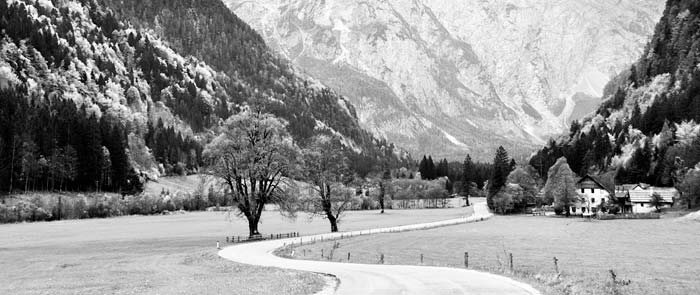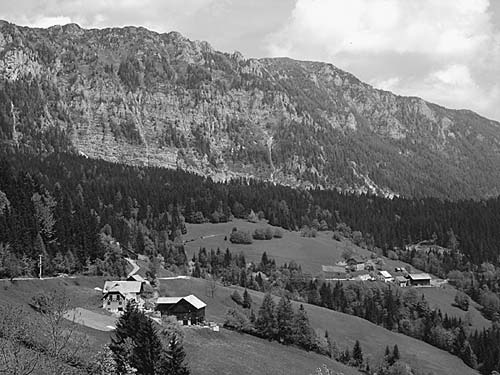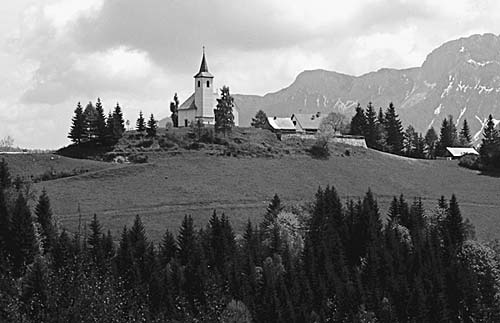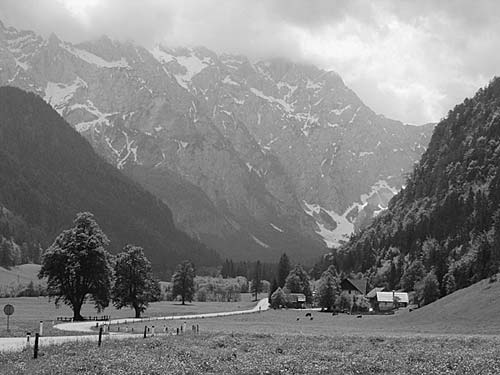
Orientation to Logarska Dolina
The Julian Alps around Lake Bled are Slovenia’s most accessible and most famous pincushion of peaks. But the high-mountain thrills don’t end there. Stretching to the east, along the border with Austria, is the Kamniško-Savinjske range—home to several very remote valleys. One particularly inviting nook between the cut-glass peaks is the time-passed valley called Logarska Dolina. To get way, way, way off the beaten track—with gravel roads, unpasteurized milk, and the few Slovenes who still don’t speak English—head to Logarska Dolina, its surrounding valleys, and the breathtaking Panoramic Road above them all.
Logarska Dolina—very loosely translated as “Woodsman’s Valley”—thrills adventurous drivers, true back-to-nature nuts, and those intrigued by old-fashioned farming lifestyles...or, better yet, travelers who are all of the above. Most of all, Logarska Dolina is the ideal excuse for a long drive on high-mountain roads to one of Slovenia’s most traditional corners.
Traveling here, you come to appreciate the vibrant culture and history that pervades even this remote and rugged corner of a tiny country. Some 25,000 years ago, hardy Ice Age people already lived in Logarska Dolina. Archaeologists have uncovered some remarkable remains from these prehistoric times—mostly tools made from bone, among them a flute and the oldest needle ever discovered. Today’s residents focus on sheep, and locally made products—from cheese to thick felt hats, vests, and slippers—are a proud Logarska Dolina symbol. Other treasured aspects of the local culture include woodcarving, marble carving, rollicking zither sing-alongs, and huge ceramic stoves that work hard to keep mountain folk warm through the frigid winter.
If you want to dig deep into the Slovenian mountains—like the glaciers that carved Logarska Dolina during the last Ice Age—this is the place. Slovenes like to keep this getaway a secret; it’s one of their favorite escapes from the daily grind (and, along with Lake Bled, one of the country’s most popular places to get married). Travelers who find Lake Bled too touristy prefer Lake Bohinj (see here). But travelers who think Bohinj is too touristy...love Logarska Dolina.
A trip to Logarska Dolina can be done as a long full-day circular drive from either Bled or Ljubljana. But to really escape to the mountains, spend the night. If you’re heading between Ljubljana/Bled and Ptuj/Maribor on the A-1 expressway, Logarska Dolina is roughly on the way (though it’s still an hour off the expressway).
I’d skip this region without a car. Public transportation to the northern valleys is extremely time-consuming. In summer only, one bus each weekday goes from the city of Celje to Solčava, then on to Logarska Dolina. But once you’re there, many of the region’s best attractions (such as the Panoramic Road) are unreachable by public bus. In the summer, the Center Rinka in Solčava may be able to help arrange a shared shuttle bus (€75/person from Ljubljana; see contact info later, under “Tourist Information”).
On the other hand, Logarska Dolina is made to order by car. The valley is nearly due north from Ljubljana. But because of the mountains that lie between them, you’ll need to boomerang substantially to the east to get there. From Ljubljana, take the A-1 expressway east (toward Celje) to the Šentrupert exit. From here, most of the route is well-marked with brown Log Dolina signs. Head north on road 225 along the Savinja River, past Mozirje and Nazarje, then continue northwest on road 428 through Ljubno, Luče, and Solčava. (For details on getting around the valleys once you’re in Solčava, see “Route Tips for Drivers,” later.) Figure about an hour from Ljubljana to the Šentrupert exit, then another hour to Solčava.
A good, detailed map is essential. The Avtokarta Slovenija map will do, but consider getting one with even more detail for this region (such as the 1:50,000 Zgornja Savinjska Dolina map, available locally).
The route I’ve described above is the best. Detailed maps will show some seeming “shortcuts” that appear to take you more directly between Ljubljana and Logarska Dolina—but these will actually cost you time. I’ve tried both of the most likely options: the easier version, through Kamnik, then over the mountains via Gornji Grad to pick up the main road into Solčava (near Ljubno); and the off-road version of this route, cutting the corner from Krivčevo north (on unpaved roads—impassable outside of summer) through Podvolovljek to Luče. These alternatives come with some beautiful scenery and save you miles, but they are very time-consuming. (If you take the Kamnik route and have good weather, it’s worth the 3-mile detour north to ride the cable car to the spectacular high-mountain meadow of Velika Planina, speckled with traditional cattle farms—see www.velikaplanina.si.) Another seeming shortcut via Kranj—dipping into Austria on the impossibly twisty Jezersko-Pavličevo Sedlo road, through Vellach—is also possible, and also time-consuming.
This area—also called Solčavsko—is tucked in the northern corner of Slovenia, just a few miles from Austria. Although vast (about 40 square miles), the area has only 580 inhabitants. This chapter’s sights branch off from an east-west axis formed by the valley of the Savinja River. The main attraction here is the valley called Logarska Dolina, which cuts through the mountainscape south from the Savinja River Valley. Roughly parallel to Logarska Dolina are two smaller valleys: gentle Robanov Kot to the east and rugged Matkov Kot to the west. (Dolina means “valley;” kot—literally, “corner”—is a short valley.) Running along the top of the Podolševa ridge above the Savinja River is the rough, gravelly Panoramic Road (Panoramska Cesta)—with spectacular views over the entire region.
The region’s best source of information is in Solčava, at the Center Rinka, which hands out maps and brochures, has a good exhibit about the region, can help you find a room or plan a hike, and can arrange activities such as guided hikes, bike rental, horseback riding, rock climbing, archery, and paragliding (daily June-Aug 8:00-20:00, April-May and Sept 8:00-18:00, Oct-March 8:00-15:00, Solčava 29, tel. 03/839-0710, www.solcavsko.info, info@solcavsko.info). For more on the Center Rinka, see “Sights in Logarska Dolina,” later.
Within Logarska Dolina, there’s a modest TI kiosk across the parking lot from Hotel Plesnik (very flexible hours but generally May-Oct daily 9:00-15:00, closed Nov-April and in bad weather, take left fork to hotel after you enter Logarska Dolina to Logarska Dolina 9, tel. 03/838-9004, www.logarska-dolina.si). If it’s closed—as is the case off-season—the nearby Hotel Plesnik also provides basic tourist information. There’s also a TI along the main road in Luče (tel. 03/839-3555).
The road along the Savinja River, and the Panoramic Road up above, are connected at both ends—forming a handy loop that allows drivers to see everything efficiently. I suggest driving the Panoramic Road first, to get a good overview of the region, then winding down along the Savinja River to see the valleys. (If you have bad morning weather that looks like it may clear up in the afternoon, do the opposite.)
Route Tips for Drivers: The town of Solčava is the gateway to the region and has the handy and interesting Center Rinka. From Solčava, you can twist up to the Panoramic Road (follow signs to Podolševa). At the far (west) end of this sky-high road, you’ll come to a fork: Going left drops you directly down into Logarska Dolina, while going right takes you toward the Austrian border at Pavličevo Sedlo, and a very rugged, gravelly loop around the top, then bottom, of Matkov Kot (easy to miss—follow signs for tourist farms).
After visiting Logarska Dolina, take the Savinja River road back to Solčava. If you have time, you can detour into the valley of Robanov Kot when you head south from Solčava.

The Logarska Dolina valley itself (described later) is beautiful. But the region’s spectacular highlight is the Panoramic Road twisting along the top of the cliff above it. At an altitude of around 4,000 feet (compared to about 2,500 feet in Logarska Dolina), this road offers one thrilling drive.
As you rattle along the rough road, all around you are vast swaths of mountain forests, broken only by hilltops covered with patches of green grass. Each of these hills is its own farm, which raises grass to feed livestock (see sidebar). Several stretches of the Panoramic Road (including the switchbacks up from Solčava) are what Slovenes poetically call “white roads”—that is, unpaved gravel. (If you’re wary of driving on gravel, you may want to skip the road up from Solčava and instead do the Panoramic Road round-trip, using the paved road up from near Logarska Dolina.) Realize that you’re just an avalanche’s tumble from the Austrian border.
About halfway along the Panoramic Road, the late 19th-century Church of the Holy Spirit (Sveti Duh) hovers on a hilltop above the hamlet of Podolševa. Climb up to the church for sweeping views over Logarska Dolina. If the church is open, duck inside and find a very unusual relief of three men representing the Holy Trinity. God is in the center, Jesus is on the left, and on the right, it’s the Holy Spirit, depicted not as a dove but as a balding man.

Watch for pullouts offering stunning views all along the Panoramic Road; the best stretch is between the Klemenšek and Žibovt tourist farms. Pack along a picnic, or consider stopping off at a tourist farm for a meal (Tourist Farm Klemenšek owns some of the best views in the region—listed under “Eating in Logarska Dolina,” later). Some farms serve kislo mleko, or “soured milk”...which is exactly what it sounds like. Fresh, unpasteurized milk is set out in the open air, usually in a darkened room. The fat rises to the top and forms a skin on top. The bottom of the milk is like yogurt, white and relatively flavorless. Meanwhile, the yellowish top layer comes with a kick: a pungent barnyard aftertaste. I tried it—once—and enjoyed it...the experience, if not the flavor.

This valley, 4.5 miles long and about a quarter-mile wide, is the region’s main draw. A flat, broad meadow surrounded on all sides by sheer alpine cliffs, it’s an idyllic place for a drive, hike, or bike ride. Various sights—caves, waterfalls, old log cabins, and so on—surround the valley, but it’s most appealing simply as a place to commune with gorgeous Slovenian nature.
Though you can enter the valley year-round, you’ll pay a €7 entry fee per car from April through October (at other times, or if there’s bad weather and the entry kiosk is closed, it’s free). After the valley entrance, the road forks. Take the left fork to reach the TI kiosk (see “Tourist Information,” earlier) and hotels; or take the right fork to bypass them (the two forks eventually rejoin).
At the far end of the valley, you’ll find a parking lot with some snack stands. From here, you can follow the Slap Rinka—10 min signs up the moderately strenuous path to the Rinka Waterfall. This is where mountain runoff tumbles into the valley, feeding the Savinja River, which courses through the valley and region. Relax at the little mountain hut called Orlovo Gnezdo (“Eagle’s Nest”) and enjoy a drink with a view of the falls, which plunge 300 feet down from the adjacent cliffs.
With more time, Logarska Dolina offers an inviting, mostly level place to go for a longer hike, surrounded by cow-filled meadows and towering peaks. The “Nature-Ethnographic Trail” is a two-hour, four-mile (one-way) hike that starts near the entrance of the valley and leads to the end of the valley. A brochure that describes the route is available at the Logarska Dolina TI kiosk and at the Center Rinka, along with information about more adventurous hikes up into the region’s mountains.
This sleek new building sits along the main road in the village of Solčava, just 50 yards from the twisty route up to the Panoramic Road. Named for the big waterfall that feeds the Savinja River (which carved out this region’s beauty), it’s a state-of-the-art visitors center that celebrates the local landscape and culture. A small but endearing—and free—exhibition on the natural area includes displays about area caves and the prehistoric findings unearthed in them, local handicrafts (felt and woodworking), trees, wildflowers, and animals. It provides a good foundation for exploring the region, and the 15-minute film makes you wish you had more time here. The center also offers a free Internet terminal and Wi-Fi, a café/bar selling some locally made products (meats, cheeses, and cookies), a shop with an enjoyable variety of local handicrafts, and a children’s play area. A second exhibition hall is planned nearby to show off their remarkable collection of Triassic fossils and local butterflies. A visit here is smart both in good weather (to plan your high-mountain fun) and in bad weather (to learn about the region without getting wet).
Cost and Hours: Free, daily June-Aug 8:00-20:00, April-May and Sept 8:00-18:00, Oct-March 8:00-15:00, Solčava 29, tel. 03/839-0710, www.solcavsko.info.
Nearby: The village of Solčava itself is a pleasant place, hemmed in tightly by alpine cliffs and capped by the picturesque Church of Christ the King.
These smaller, sleepier valleys, dotted with traditional farm buildings, flank Logarska Dolina. They offer the same surrounded-by-mountains feeling, but they’re less cultivated and less crowded than Logarska during the peak season. With extra time, poke into one or both of these mini-valleys simply to enjoy the peaceful views.
Robanov Kot, near Solčava, is more gentle and accessible, with better and more level roads. This valley is well-marked with a brown sign just south of Solčava; it’s home to the recommended Tourist Farm Govc-Vršnik.
The Matkov Kot road is more rugged, with cliff-hanging gravel portions that can feel like little more than tractor ruts. But the valley scenery is breathtaking (sometimes literally)—and arguably rivals the Panoramic Road. Adventurous drivers who enjoy mountain vistas will find it worth the grinding gears. It’s easy to miss this poorly marked valley—look for signs to the tourist farms (the recommended Tourist Farm Perk is on this road) and for Matkov Škaf.
If you have ample time here, you can consider some other offbeat attractions that are more charming than thrilling.
The Firšt Gostišče—which has a restaurant and rents rooms on the road between Solčava and Logarska Dolina—has a cave on their property called Fidova Zijalka, where a 19th-century hermit named Fida lived and served as the medicine man for the local community. But Fida wasn’t the first to live in this cave, and its discovery and scientific exploration helped advance our modern understanding of life during the last Ice Age. Honoring this heritage, the Firšt family operates their own modest, dry, two-room museum of prehistoric cave findings and folk medicine (€2, same hours as restaurant—see here). They also have an “ethnographic park”: Pay €4 and pick up the essential English guidebooklet at the main building, then hike steeply up into the hills behind for a one-hour loop that takes you to the cave, with commentary en route about local flora, fauna, and farming lifestyles.
If you’re traveling with kids, consider paying a visit to the Fairytale Forest, next to and run by the recommended Na Razpotju Guesthouse in the middle of Logarska Dolina. Speckled through a gentle wood are 35 wood carvings illustrating local fairy tales, all explained in English (€2.50/child, €3.50/adult, April-Nov daily 10:00-18:00; listed under “Sleeping in Logarska Dolina,” next).
All of my listings are in Logarska Dolina or within about a 15-minute drive. Many accommodations in this region have their own restaurants, and it’s common (and typically a good value) to take “half-board” at your accommodation—dinner (or sometimes lunch) for a fixed additional price. There are no restaurants in this area that are worth going out of your way for, so eating where you sleep makes sense.
These options sit in the valley of Logarska Dolina itself. They’re listed in the order you’ll reach them as you drive down the valley.
$$$ Hotel Plesnik and Vila Palenk, both part of the only big hotel outfit in the area, sit proudly in the middle of Logarska Dolina. The hotel, with lively public spaces and 30 modern rooms with traditional farmhouse furnishings, is a big, classy, overpriced splurge (Sb-€98, Db-€144, elevator). The nearby, smaller Vila Palenk has 11 rustic rooms with more character (Sb-€79, Db-€136, no elevator, breakfast at the main hotel). The staff at both places speak English. Reservations for both are handled through the same office (€12/person for dinner at hotel restaurant, check online for discounts, indoor swimming pool, Logarska Dolina 10, tel. 03/839-2300, www.plesnik.si, info@plesnik.si). After entering Logarska Dolina, you’ll come to a fork; bear left to reach the hotel.
$$ Lenar Tourist Farm rents six rooms and three apartments with cozy farmhouse decor in two adjacent homes with nice views over a small orchard and the grand valley of Logarska Dolina (Db-€60, apartment for up to 6 people-€100, cash only, free Wi-Fi, Logarska Dolina 11, mobile 041-851-829, www.lenar.si, tk.lenar@siol.net).
$$ Ojstrica Country House has nine simple rooms and a restaurant halfway along Logarska Dolina (Db-€64, €82 with dinner, cheaper for multinight stays with dinner packages, free Wi-Fi, Logarska Dolina 13a, tel. 03/838-9051, mobile 041-664-455, www.logarska-ojstrica.si, info@logarska-ojstrica.si).
$$ Na Razpotju Guesthouse (“At the Crossroads”) is designed for families, with 10 colorful rooms and a mini-theme park of carved fairy tales (Sb-€45, Db-€70, dinner-€10/person, free Wi-Fi, a quarter-mile from Hotel Plesnik toward the far end of the valley, Logarska Dolina 14, tel. 03/839-1650, www.logarska-narazpotju.si, razpotje@siol.net).
In Robanov Kot: $$ Tourist Farm Govc-Vršnik (pronounced “goats vurshnick”)—in the smaller, relaxing valley of Robanov Kot (a scenic 15-minute drive from Logarska Dolina)—is my favorite option in the region, and the most modern and accessible of my tourist farm listings. English-speaking Marjana and the Vršnik family run this farm with a soft-spoken, warmhearted hospitality. They have cows, a traditional beehive, and 10 cozy rooms with bright, woody decor (Db-€60, €80 with dinner, 20 percent more for 1- or 2-night stays, cheaper mid-Oct-late April, cash only, free Wi-Fi, Robanov Kot 34, tel. 03/839-5016, www.govc-vrsnik.com, govc.vrsnik@siol.net). As you enter the valley of Robanov Kot (just south of Solčava), watch for signs (it’s the second tourist farm on the left).
Between Solčava and Logarska Dolina: $ Firšt Gostišče, situated along the picturesque riverside road just outside Logarska Dolina, feels like a rural rest stop, with a popular restaurant, six straightforward rooms, and a small museum about local prehistoric finds (Db-€50, 1-night stay-€12 extra, 2-night stay-€6 extra, dinner-€9/person, cheaper Oct-May, free Wi-Fi, Logarska Dolina 1a, tel. 03/839-4678, www.first-logarska.si).
On the Panoramic Road: $ Tourist Farm Žibovt is dramatically situated at the far end of the Panoramic Road, a few minutes’ walk from the Austrian border. It perches on a ledge with fine views of a tranquil meadow that ends at a sheer cliff plunging to the bottom of Logarska Dolina. In addition to renting six cheery rooms, the Poličnik family serves meals and turns out a wide range of dairy products—including the unforgettable kislo mleko (“soured milk”). They also make traditional wooden games and have beehives that produce homemade honey; a small marble quarry is nearby (Db-€52, or €70 with dinner, extra for 1-night stays, cash only, closed mid-Oct-mid-April, Logarska Dolina 24, tel. 03/584-7118, www.nad1000m.si/zibovt, kmetija.zibovt@gmail.com, Žarko and Martina Poličnik). The farm is well-marked at the far end of the Panoramic Road (near the Austrian border crossing at Pavličevo Sedlo).
Overlooking Matkov Kot: $ Tourist Farm Perk is the most rustic of my listings, with seven simple, older-feeling, but budget-priced rooms (some of which have a private bathroom on the hall). It’s scenically perched on the particularly remote-feeling gravel road high above Matkov Kot (D/Db-€52, €60 with dinner, cash only, Logarska Dolina 23, tel. 03/584-7120, mobile 041-282-485, www.perk.si, info@perk.si, Krivec family speaks limited English).
Many of the region’s tourist farms serve full meals to passersby in summer and light meals and snacks at other times. The food here is traditional and heavy, and no place is worth a long drive for a meal. Base your decision on convenience.
Picnics: The best option is to bring a picnic with you and eat whenever you find the scenic perch you like best. If you wait to buy your picnic until you reach the valley, you’re too late. Instead, shop at one of the small grocery stores along the main road in Luče or Solčava. Also in Solčava, the Center Rinka’s café/bar sells locally produced meats and cheeses to supplement your picnic. Spectacularly located picnic benches punctuate the Panoramic Road, including ones a few hundred yards on either side of the recommended Tourist Farm Klemenšek.
In Logarska Dolina: Several of my recommended accommodations also have food, including Hotel Plesnik (big restaurant with pricey food—€7-10 pastas, €13-24 main courses, daily 12:00-15:00 & 18:00-20:00) and Ojstrica Country House (woody, convivial space with a bar frequented by locals, affordable €8-10 meals, daily 12:30-15:00 & 18:00-20:00). On the road between Logarska Dolina and Solčava, Firšt Gostišče serves up €6-8 small meals and €9-18 main courses (Tue-Sun 12:00-21:00, closed Mon).
On the Panoramic Road: Tourist Farm Klemenšek, set on a grassy ridge with spectacular views, has the classic Logarska Dolina setting, home cooking, and indoor or outdoor tables (July-Aug daily 11:00-21:00; May-June and Sept-mid-Oct Sat-Sun only 11:00-21:00, closed Mon-Fri; closed mid-Oct-April; halfway between Sveti Duh and the end of the Panoramic Road, tel. 03/838-9024, www.na-klemencem.si).
This scenic, 700-year-old, hill-capping castle seems out of place over the modern industrial town of Velenje (which was once named “Titovo Velenje” for the Yugoslav dictator, Tito). Even more unusual is the eclectic, extensive, and endearing museum it houses. While it’s not worth going far out of your way to see, a trip to the castle makes a good rainy-day activity or a fine diversion if you’ve got extra time at the end of your Logarska Dolina day.
Cost and Hours: €2.50, Tue-Sun 10:00-18:00, closed Mon, Ljubljanska cesta 54, tel. 03/898-2630, www.muzej-velenje.si.
Getting There: Velenje Castle is easy to visit en route to or from Logarska Dolina, especially if you’re headed east on the expressway. From the road connecting Logarska Dolina to the expressway, you can detour east just south of Mozirje (via Gorenje) into Velenje, where you’ll look for easy-to-miss brown signs to turn off for the castle. From Velenje, you can head south straight to the expressway.
Visiting the Castle: Only some of the exhibits are described in English, but you can borrow the good English descriptions when you enter. If the guides aren’t busy, one of them can show you around (included in ticket price). Better yet, call ahead to see if an English tour is scheduled, or to request a tour for yourself.
You’ll find a surprising diversity of exhibits surrounding the tranquil castle courtyard: replicas of a circa-1930s general store and pub; a Czech professor’s three-room collection of African art and everyday items; a survey of regional history through the Middle Ages, including a replica of a countryside home; a city history overview (the town was founded only after World War II, so much of the story dates from Tito’s Yugoslav era); an exhibit on the WWII experience in the local area; various Slovenian paintings and sculptures; and temporary exhibits. Separate buildings house a collection of Baroque church art and an exhibit on mastodons (the remains of two of these extinct tusked mammals were found near here in 1964).